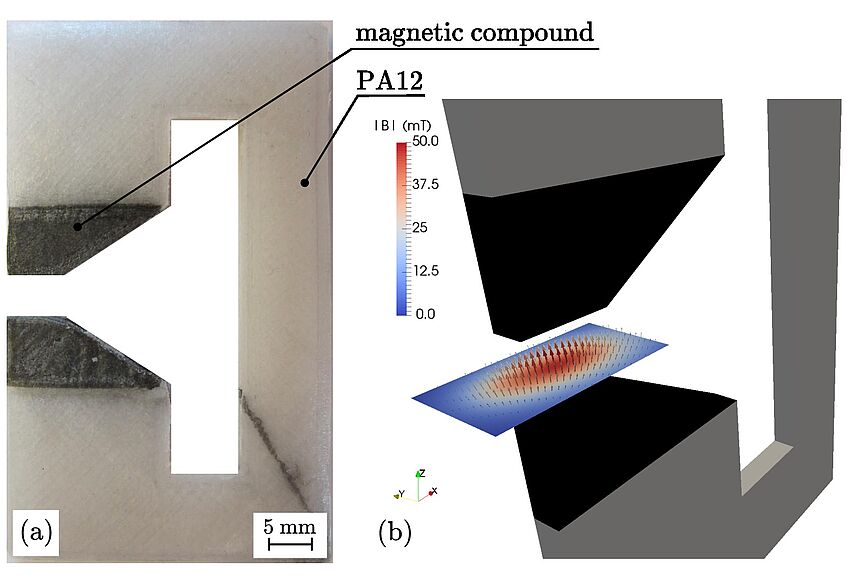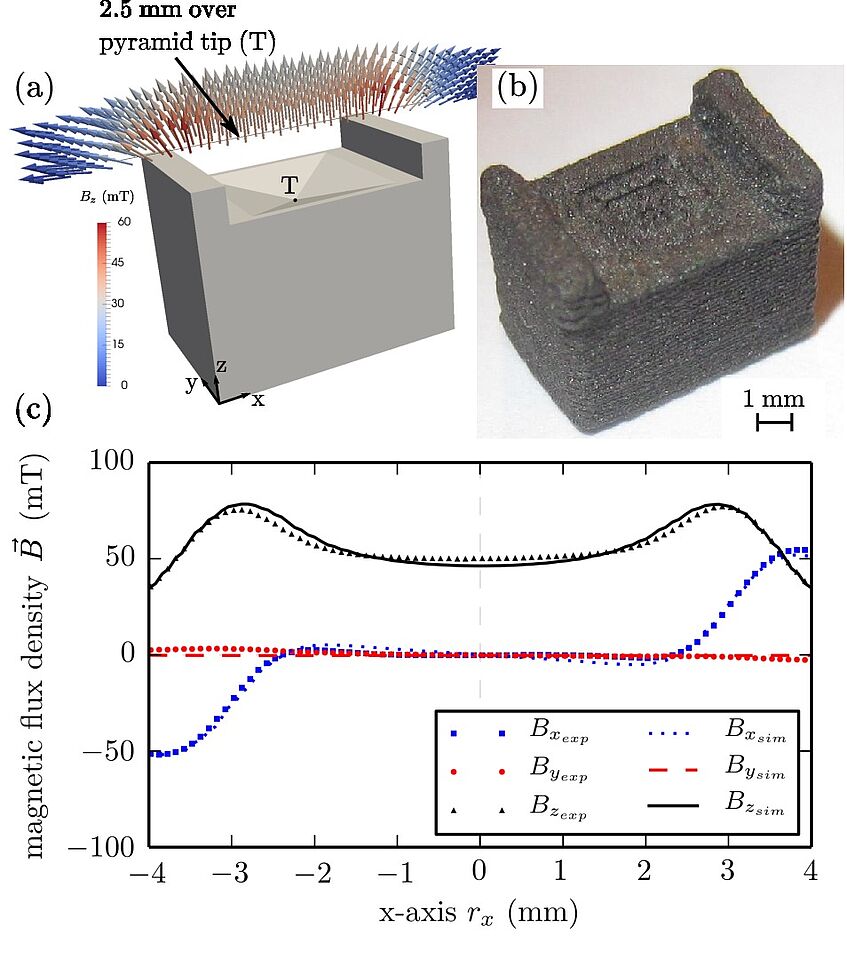3D Printing of Magnets

Printed system made of two materials. (a) Picture of a yoke with permanent magnetic poles. (b) Measurement of the stray field B~ in the middle of the yoke.
In commercial applications two main types of magnets exists. For high performance application where high fields are required sintered NdFeB magnets are used. Besides sintered magnets about 10% of NdFeB magnets are polymer bonded magnets (9000 tons with a market share of about 750 Million USD) which generate smaller magnetic field but enable the manufacturing of complex shapes and features by design flexibility regarding shape and magnetizing structure.
The success of polymer bonded magnet can be found in the fact that in various sensor applications the main purpose of the permanent magnet is not to generate fields with highest field strength but unique and reproducible field profiles are required. An example are ABS sensors for cars, where a polymer bonded permanent magnet is used to magnetize a rotating soft magnetic gear-wheel. Depending weather a tooth is or is not above the magnet the total field is different. From this sequence of large and small fields the rotation speed can be extracted. The magnetic field is measured by a magnet field sensor such as HALL, GMR or TMR sensor. For the application it is required that the field is maximized in one direction and in orthogonal directions as small as possible.

Printed magnet and characterization of a magnet with a specific field above the magnet. (a) Geometry of the permanent magnet, and area scan of B~ with a step size of 0.1 mm in the middle of the magnet. (b) Picture of the printed isotropic NdFeB magnet with Neofer ® 25/60p with optimized shape to suppress Bx and By along the x-axis rx. (c) Line scan 2.5 mm over pyramid tip (T) compared with FEM simulation of the magnet with perfect shape.
This requirement can only be fulfilled with complicated shapes of the magnet. If in addition to the shape of the magnet the magnetic material as well as the orientation of the magnetic moments can be designed as function of space, new designs can be realized allowing for example higher manufacturing tolerances.
3D printing of magnets is a new technology which can be used to realize this goal [1]. The most important ingredient to transform a commercial 3D printer to a small sized magnets manufacturer is the filament which is usually a polymer. This polymer has to be replaced by a mainly magnetic material. In our case we use a compound of isotropic NdFeB particles inside a PA11 matrix which is extruded to filaments that is also a typical material used in polymer bonded magnets.
This filament is used by our 3D printer, which is a commercially available fused deposition modeling printer. This printer manufactures the structure layer by layer by a meltable thermoplastic. The filament is heated above its softening point and extruded through a movable nozzle. The object is build up in layers on the already solidified material on the printer bed. Finally an object is obtained which is build out of magnetic material which is very similar to the material of standard polymer bonded magnets.
Selected Publications
- Huber, Christian, et al. "Additive Manufactured Polymer-Bonded Isotropic NdFeB Magnets by Stereolithography and Their Comparison to Fused Filament Fabricated and Selective Laser Sintered Magnets." Materials 13.8 (2020): 1916.
- Huber, Christian, et al. "Topology optimized and 3D printed polymer-bonded permanent magnets for a predefined external field." Journal of Applied Physics 122.5 (2017): 053904.
- Huber, Christian, et al. "3D printing of polymer-bonded rare-earth magnets with a variable magnetic compound fraction for a predefined stray field." Scientific reports 7.1 (2017): 1-8.
- Huber, C., et al. "3D print of polymer bonded rare-earth magnets, and 3D magnetic field scanning with an end-user 3D printer." Applied Physics Letters 109.16 (2016): 162401.
